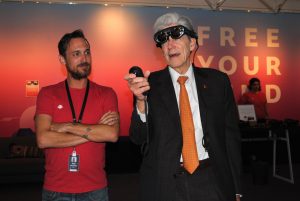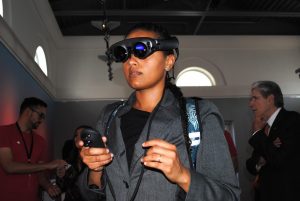
Miami, Nov 12 (EFE).- The University of Miami on Monday unveiled a partnership with the start-up company Magic Leap for the development of educational projects in the digital realm using augmented reality.
The president of that institution of higher learning, Mexican-born Julio Frenk, told EFE that a digital scenario can be created through this technology that allows people to interact with others who do not share the same physical space.
“Known as ‘spatial computing,’ this technology can take elements of physical reality to create and spectacularly expand human beings’ ability to interact with one another,” Frenk said after Monday’s presentation at the university’s main campus in Coral Gables, Florida.
The distance separating two people located in two different countries is not an obstacle due to augmented reality, since they can interact as if they were side by side.
“In addition to expanding opportunities in the research area, it also creates unprecedented opportunities for educational exchanges,” Frenk said.
“At a time when we’re seeing new restrictions on mobility, we can overcome them with a technology that truly eliminates friction and space,” he added, noting that his university is the first to sign a partnership deal with Magic Leap.
Magic Leap’s founder and CEO, Rony Abovitz, also hailed the technology during the presentation, noting that a chemistry professor in a particular classroom could have five additional students who are physically located in other parts of the world.

Abovitz, who years ago earned a BS in mechanical engineering and an MS in biomedical engineering from the University of Miami, said spatial computing can be ground-breaking in the fields of communications, science and entertainment.
The Magic Leap product, known as the “Magic Leap One Creator Edition,” is a wearable computer featuring augmented reality headset goggles that allows users to build their own “Magicverse” (bridge the physical world and the digital world).
Abovitz, who has been developing this project in recent years with financing from large companies such as Google and Qualcomm, explained that a digital copy can be made of a scene – not just a static one, but one dynamic and alive.
The goal, he said, is to clone that same physical space as if it were real.
The natural evolution of communications devices and computers has given way to this spatial computing technology, which will revolutionize the world just as Steve Jobs did with the iPhone in 2007, Abovitz said.
He said Magic Leap wants students to use this technology to invent things of their own.

For example, an architect would be able to digitally construct a building and insert it in a space to observe how it would fit there and what impact it would have on that place.
Likewise, a surgeon could use the headset during an operation to follow the procedure and monitor the patient’s progress without the need to use additional control screens.
The development of this technology, in Abovitz’s opinion, can play a key role in driving Latin America’s economy, just as occurred in India and China with information technology and consumer electronics, respectively.
He said Latin American countries such as Mexico and Brazil could make the leap to spatial computing through the work of thousands of software engineers, adding that they could create a very interesting economy in that region.
